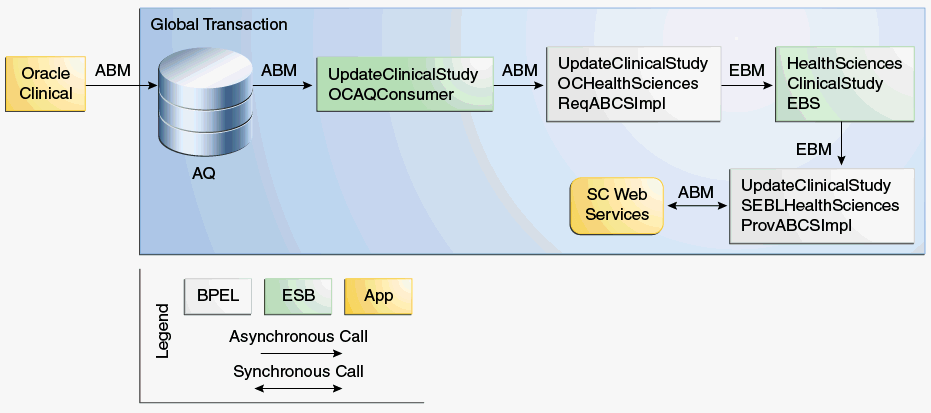| Oracle® Study, Subject, and Visit Synchronization Integration Pack for Siebel Clinical and Oracle Clinical Implementation Guide Release 11.1 E36156-01 |
|
|
PDF · Mobi · ePub |
| Oracle® Study, Subject, and Visit Synchronization Integration Pack for Siebel Clinical and Oracle Clinical Implementation Guide Release 11.1 E36156-01 |
|
|
PDF · Mobi · ePub |
This chapter provides an overview of automating the update of activity completion date and status based on data that is collected in Oracle Clinical or Oracle Clinical Remote Data Capture (OCRDC) and discusses:
In Siebel Clinical, activities are scheduled to happen at patient visits. The patient visit itself is considered an activity. The data in Oracle Clinical can be used to send activity status information to Siebel Clinical. For this to happen, the completion criteria for an activity or visit must be defined. The completion criteria is defined by indicating which visit, DCIs, DCMs, or DCM questions in Oracle Clinical must be completed for the activity or visit to be considered complete. An activity may be specific to a visit or could occur at multiple visits.
You can schedule a new batch job in Oracle Clinical that analyzes the patient data entered since the last time the batch job was run to see if the completion criteria have been met or changed. The process can be configured to run periodically on a custom schedule.
When the Track Activities menu item is selected and the study in context is not enabled for Subject Activity integration, an error occurs, and you are prompted to select a new study.
If the study context does not exist when the Track Activities menu is selected, you are prompted to select a new study.
You can change the study context while in the Track Activities form by selecting Special > Click Study or Change Study.
During the process, the system will evaluate new patient data that has been modified since the last time the process ran to determine if activities are complete or not. If any activity completion criteria has been made active since the last time the process ran, all patient data is checked to see if any activities have been completed.
The integration will send a message to Siebel Clinical to update the completed date and status of the activity or visit.
For more information, see Setting Up the Participating Applications
This section provides the activity diagrams and functional descriptions for Clinical Study Subject Activity Flow. This is not a synchronization flow but data from Oracle Clinical is used to update the completion date and status of a Subject activity or visit in Siebel Clinical.
The following diagram shows the Clinical Study Subject Activity flow:
Figure 4-1 Clinical Study Subject Activity Flow

The following list describes the update subject visit or activity completion flow:
When Subject Activity Integration is enabled for a study in Oracle Clinical and activity completion criteria have been defined, running the Track Activity batch job in Oracle Clinical will write a ClinicalStudy (ABM) to the Clinical_Study_Queue Advanced Queue (AQ) when the completion date of an activity has changed.
For more information about Oracle Clinical prerequisites, see Setting Up the Participating Applications
The UpdateClinicalStudyOCAQConsumer adapter service picks the message and passes it to the UpdateClinicalStudyOCHealthSciencesReqABCSImpl (requester ABCS).
The message will then be transformed into an UpdateClinicalStudy EBM and the ClinicalStudySubject Identification is retrieved from the ClincialStudy_ClinicalStudySubjectId cross-reference table.
The UpdateClinicalStudyEBM is passed onto the HealthSciencesClinicalStudyEBS (EBS).
The EBS will follow routing rules to pass the EBM onto the UpdateClinicalStudySEBLHealthSciencesProvABCSImpl (provider ABCS).
The provider ABCS transforms the EBM into an ABM for the Siebel Clinical Web service. During this process, the Siebel Clinical row ID for the Subject from the ClinicalStudy_ClinicalStudySubjectId cross-reference table is retrieved.
A synchronous call is made to the Clinical Subject Web service in Siebel Clinical.
These processes are part of a global transaction. Compensating steps will be taken if an error occurs at any point that prevents the process completion.
Outbound from Oracle Clinical Event Interfaces:
Oracle Clinical writes ClinicalStudy ABM to the CLINICAL_STUDY_QUEUE AQ.
The integration flow uses the following components:
ClinicalStudy EBO
HealthSciencesClinicalStudyEBSV1
UpdateClinicalStudyEBM
The industry EBO and EBM XML Schema Definition (XSD) files can be located by EBO within the following parent folder:
$AIA_HOME/AIAMetaData/AIAComponents/EnterpriseObjectLibrary/Industry/HealthSciences/EBO/
The industry EBS Web Services Description Language (WSDL) files can be located by EBO within the following parent folder:
$AIA_HOME/AIAMetaData/AIAComponents/EnterpriseBusinessServiceLibrary/Industry/HealthSciences/EBO/
For detailed documentation of individual EBOs and EBMs, click the AIA Reference Doc link on EBO and EBM detail pages in Oracle Enterprise Repository or Oracle Clinical.
For more information about using the Oracle Enterprise Repository and configuring it to provide the AIA Reference Doc link, see Oracle Fusion Middleware Developer's Guide for Oracle Application Integration Architecture Foundation Pack 11g Release 1, "Configuring and Using Oracle Enterprise Repository as the Oracle AIA SOA Repository."
EBOs can be extended, for instance, to add new data elements. These extensions are protected and will remain intact after a patch or an upgrade.
For more information, see Oracle Fusion Middleware Concepts and Technologies Guide for Oracle Application Integration Architecture Foundation Pack 11g Release 1, "Understanding Extensibility".
These are the services delivered with this integration:
UpdateClinicalStudyOCAQConsumer
This is an AQ adapter consumer service that reads an XML message from the AIA_ClinicalStudyQ in Oracle Clinical database. This service routes the ABM to the Requester ABCS, UpdateClinicalStudyOCHealthSciencesReqABCSImpl.
UpdateClinicalStudyOCHealthSciencesReqABCSImpl
This requester ABCS is responsible for transforming the Oracle Clinical ClinicalStudy ABM into an UpdateClinicalStudyEBM.
HealthSciencesClinicalStudyEBS
This EBS service is responsible for passing the message from the Requester ABCS to the Provider ABCS.
UpdateClinicalStudySEBLHealthSciencesProvABCSImpl
This Provider ABCS is responsible for transforming the UpdateClinicalStudyEBM into the appropriate ABMs that will call the appropriate Siebel Clinical Web service.